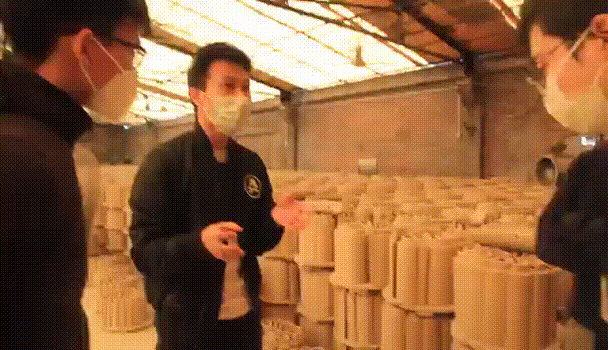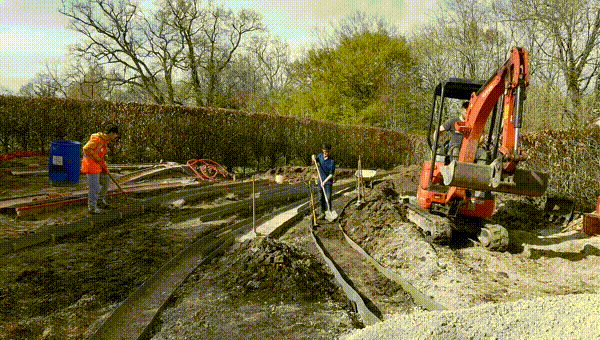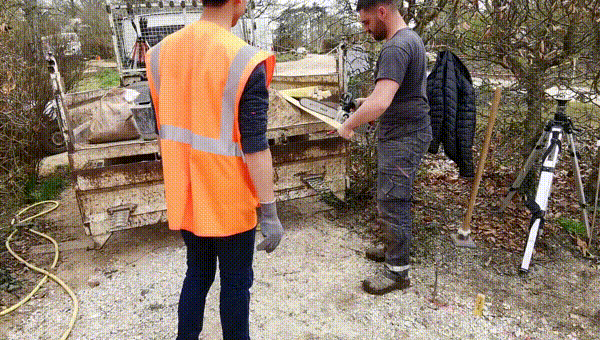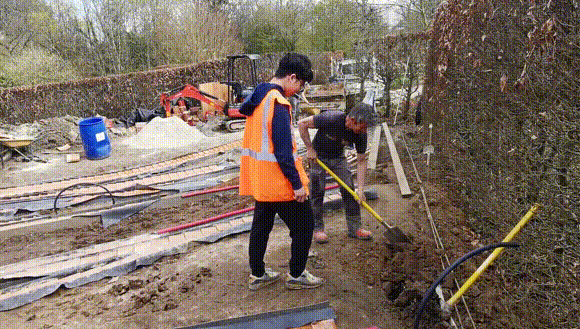本文由 风物营造 授权mooool发表,欢迎转发,禁止以mooool编辑版本转载。
Thanks Landtek Group for authorizing the publication of the project on mooool, Text description and images provided by Landtek Group.
风物营造:生命通过杂交创造新的基因以推动进化,最终汇聚成大千世界,文化交流未尝不是如此。在异国造花园的旅程后,新的设计基因默默注入进了风物营造,在此以本文分享给每位读者。
——陆诗蕾 刁荆石
Landtek Group: Just as new genes emerge through hybridization to drive evolution and shape our diverse world, cultural exchange can work in a similar way. After exploring and experiencing foreign landscapes, new design ideas quietly enrich our own environments. This article shares these fresh perspectives with you.
— Shilei Lu, Jingshi Diao
▽项目视频 video © Chill Shine丘文三映
▽肖蒙城堡下的瓦园 The tile garden under Chaumont Castle

▽瓦园鸟瞰 Bird ‘s-eye view of Tile Garden

▽瓦园 Tile garden

为何造花园?Why to Built a Garden?
风物营造景观实践的核心阵地是公共空间,真正尝试花园营建缘起于2022年,那时我们读到了美国著名的景观设计师Michael Van Valkenburgh 的新书《Designing a Garden》。
作者Michael认为“the best way to learn how to design a landscape is to make one. ”与公共景观相比,花园尺度小、功能约束少、复杂程度低、实施周期短,是景观师测试设计构想并提升设计能力的绝佳机会。
The core design practice of Landtek Group are public spaces, but the real exploration of garden design began in 2022 for us. We read Michael Van Valkenburgh’s new book, Designing a Garden.
Michael argues that “the best way to learn how to design a landscape is to make one.” Compared to public landscapes, gardens are smaller in scale, have fewer functional constraints, are less complex, and can be completed more quickly. This makes them an excellent opportunity for landscape architects to test and refine their design ideas.
▽Designning A Garden , Michael Van Valkenburgh
Michael在书中提到,在他早年创办工作室之时,城市规划师Kevin Lynch便对他说:”你应该去设计大量花园,而且越快越好。 花园小,实现得快,你将从中学到很多。” Michael听从了Kevin的建议,在漫长的职业生涯里他一直没有停下造花园的脚步*。
*Page 19,《Designing a Garden》
于是,2022年底,风物营造团队在忙碌的设计事务外恰好还有闲暇的时间,便开始寻求契机来造花园。
In his book, Michael recounts advice from urban planner Kevin Lynch when he first started his studio: “You should design a lot of gardens, and do it as quickly as possible. Gardens are small, and you’ll learn a lot from them.” Following Lynch’s advice, Michael continued to design gardens throughout his long career.
By the end of 2022, with a break from our busy design projects, we seized the chance to start creating our own gardens.
何处造花园?Where to Built a Garden?
建造花园的理想契机本身应具备以下特征: 1. 极大设计自由度和实验性 2. 有靠谱的施工队能将设计落地。 3. 花园场地本身足够有魅力以激发设计创作。
于是,世界各地的国际花园节开始进入了我们的视野。世界范围内的国际花园节已经发展了整整一个世纪有余。其中富有盛名且历史悠久的法国肖蒙城堡国际花园艺术节(DOMAINE DE CHAUMONT-SUR-LOIRE International Garden Festival)是创办于1992年的一年一度的国际艺术盛事。它以重唤大众对花园艺术的关注为宗旨,并且专注于展示未来花园的思想。在过去的30多年来,这个花园节始终是花园和园艺创作领域的创意实验室。
The ideal opportunity for creating a garden should possess the following characteristics: 1. A high degree of design freedom and experimental potential. 2. A reliable construction team capable of bringing the design to life. 3. A garden site that is inherently appealing and inspiring for creative design.
As a result, international garden festivals from around the world have come onto our radar. These festivals have been around for over a century. One of the most prestigious and long-established is the DOMAINE DE CHAUMONT-SUR-LOIRE International Garden Festival, which began in 1992. This annual event aims to reignite public interest in garden art and focuses on showcasing innovative ideas for future gardens. For over 30 years, it has been a key platform for creative experimentation in garden and horticultural design.
▽2023年肖蒙国际花园节主题——弹性花园(Resilient Garden)
每年花园节的主题于前一年发布,肖蒙古堡委员会面向全世界的设计师和艺术家征集方案,在通过评委会筛选和两轮的面试后,最终选出20多个临时花园和永久花园方案进行建造。被选中的花园设计方将收到有肖蒙古堡提供的1.1万欧元建造费用和1000欧元的设计奖金,并受邀请住进肖蒙古堡,与当地施工团队一同建造花园。
Each year, the festival’s theme is announced in advance. The Château de Chaumont invites designers and artists from around the globe to submit their ideas. After a selection process that includes a judging panel and two rounds of interviews, over 20 designs for both temporary and permanent gardens are chosen for construction. Those selected receive a €11,000 grant for building their garden, a €1,000 design award, and an invitation to stay at the Château while working with local teams to bring their gardens to life.
▽肖蒙城堡的周边环境 The surroundings of Chaumont Castle

▽肖蒙城堡内部环境 The interior of Chaumont Castle

有意思的是,肖蒙古堡对花园的参观者提出“Steal my idea(偷我的点子)”的口号。坚定拥护原创设计的我们非常诧异,为何会有让大家来窃取创意的想法呢?进一步了解才知道,每届花园节的题目都由肖蒙古堡委员会设定,而这些题目都极具艺术探索价值。肖蒙古堡希望艺术家或设计师围绕这个题目去创造,并且在花园节上将花园艺术通过一个个鲜活的花园传播出去,从而影响未来的花园乃至所有的设计实践。
Interestingly, Chaumont uses the slogan “Steal My Idea” to welcome visitors. As staunch supporters of original design, we were initially surprised by the idea of encouraging people to steal concepts. However, we soon learned that each year’s festival theme, set by the Château’s committee, is intended to spark artistic exploration. The goal is for artists and designers to create around these themes, and through the festival, share their garden art in vibrant displays that inspire future gardens and design practices.
▽花园实验室 Garden lab

诚然,设计实践应该成为思想传播的载体,让好的想法流动起来,传播开来,而不是成为笼中金雀,仅作为一个受人观赏的静态对象。此前,中国设计师的作品早在2010年前后便来到了这里,如在永久展园区中留存的王澍与俞孔坚设计的花园。
Indeed, design should be a medium for sharing ideas, helping great concepts spread and evolve, rather than just becoming a static display. For example, Chinese designers’ work had already been showcased in Chaumont around 2010, such as the garden designed by Wang Shu and Yu Kongjian, which remains a highlight in the permanent exhibition.
▽俞孔坚的花园 Yu Kongjian’s garden

▽王澍的花园 Wang Shu’s garden

瓦园提案 Garden Proposal
2023年法国肖蒙城堡花园节的主题是RESILIENT GARDEN. 主办方提供了一块210平方米的标准场地供各国设计师开展设计。
The 2023 theme for the Château de Chaumont Garden Festival was “Resilient Garden.” The organizers provided a standard plot of 210 square meters for designers from around the world to work with.
▽场地平面 Site plan
我们事务所内部沿用了宾夕法尼亚大学设计学院的Workshop+Pin up方式,这是风物的主创们在读书期间所熟悉的设计沟通方式。利用一个上午的时间,项目组设计师一同坐下来,每人面前放有一张场地平面,限时90分钟快速构思自己的花园想法并绘制草图,而后立即开始集体pin up,即把大家的方案贴上墙,每人限时5分钟讲解自己的提案,最终投票选出代表风物营造的提案投向花园节主办方。
在这种设计方式下,通过对构思和讲解进行限时,设计师的大脑持续处于高度活跃的状态。并且由于无暇过度考虑实际细节,反而容易激发灵感并产生强实验性的想法。
At our firm, we used a design process inspired by the Workshop+Pin-up method from the University of Pennsylvania’s School of Design, a technique we’re familiar with from our academic background. We spent one morning where each designer quickly sketched their garden ideas on a site plan within 90 minutes. We then conducted a group pin-up session, displaying all the designs on the wall. Each person had 5 minutes to explain their proposal, and we voted to select the design that would represent our firm at the festival.
This time-constrained approach keeps designers’ minds active and often leads to more innovative and experimental ideas, as it limits detailed planning and encourages creative thinking.
▽办公室 workshop

在pin up的过程中,我们有趣地发现,草图一上墙,各人很容易看出方案出自哪位设计师之手,这充分说明了设计思路是有惯性的,而workshop的价值正在于让事务所保持活跃想法,并在对比各自方案中互相吸取养分以供进步。
最终,一个试图模糊水景及浇灌设施边界,同时挑战对历史与传统常识性理解的瓦园,以全票通过的方式确立下来。
During the pin-up session, it was interesting to see that we could easily identify which sketches belonged to which designer. This showed how design thinking follows certain patterns, and the workshop’s value lies in keeping ideas dynamic and learning from each other’s proposals.
Our final proposal, which aimed to blur the boundaries between water features and irrigation while challenging traditional concepts, was unanimously approved.
▽瓦园的最初想法 The original idea of tile Garden

瓦园的设计师介绍到:“当提及花园,往往意味着高维护和高投入。瓦园在模糊水景及浇灌之间的边界,同时通过延续中国琉璃瓦的材料性但又颠覆其使用方式,让花园兼具生态韧性和文化韧性。”
The designer of the “Tile Garden” explained: “Gardens are often associated with high maintenance and investment. The Tile Garden challenges this by blurring the lines between water features and irrigation. By reimagining traditional Chinese glazed tiles in a new way, the garden achieves both ecological and cultural resilience.”
▽传统瓦片的用途 The use of traditional tiles
▽概念阐述 Concept elaboration

瓦这种所谓的传统材料,其实它可以不是我们常规理解的僵死的传统。利用瓦的防水的特征,瓦园把传统用于做屋顶的琉璃瓦设置在了微微上扬的地面上,于是排水的瓦就成了引水蓄水的瓦。我们认为其在延续瓦的材料性的同时,颠覆了材料用法,守住了瓦的文化韧性。
Traditionally used for roofing, tiles in our design were placed on a slightly raised surface to function as water-harvesting elements rather than just drainage. This approach preserves the material’s traditional qualities while innovating its use, maintaining its cultural significance.
▽瓦园平面 Tile plan

▽竞赛阶段效果图 Competition stage renderings

2022年10月的一天,我们收到邀请参加面试的邮件。面试的评委在问了一些落地和材料问题后,说了一句,”We are very curious about the way you are using your traditional material. Looking forward to seeing your garden.” 。这暗示了我们的提案将最终入选,也开启了接下来的深化设计和来年4月份在法国造花园的旅程。
In October 2022, we received an invitation for an interview. After discussing implementation and materials, the judges said, “We are very curious about how you are using your traditional materials. Looking forward to seeing your garden.” This comment suggested that our proposal would be selected, marking the start of the detailed design phase and our journey to build the garden in France the following April.
▽面试过程 Interview process
在收到入选通知的同时, 我们还收到了一系列场地的资料、合同、以及设计任务书。细读后,我们越发感慨花园节成熟的管理。任务书中的一条触动了我们:“夏季是卢瓦尔河区域的旱季,设计师将被限制一系列的浇灌及水景用水的补充, 花园的设计需要充分考虑到这点。”
210平方米的花园的设计和建设,考虑上了区域的自然情况,设计顺应自然成为了对每个花园设计师的基本要求。可持续生态的观念以基本要求的方式落实到每个花园,这份对自然的尊重值得习以为常地通过人造基础设施挑战自然气候的景观设计师反思。收到的资料中还包含法国当地严禁种植的入侵物种条例,一些我们国内常用的植物如狼尾草被禁止使用。
异国造园所带来的紧张和焦虑令深化工作变得更难。花园构思只是第一步,接下来的工作才是挑战所在。 我们在接下来的日子里结合选材用材和施工可选的措施进行施工图设计,同步联系当地供应商并进行成本复核。花园节需要我们亲自到场参与施工,以把控施工符合设计效果。于是,大到施工计划,小到运送土方的挖土机和运输车的型号、租用天数和费用等事务都需要设计师考虑周全。
Along with the selection notice, we received site information, contracts, and a design brief. We were impressed by the festival’s thorough management. One point in the brief stood out: “Summer is the dry season in the Loire Valley, so designers will face restrictions on irrigation and water features. The garden design must account for this.”
Designing and building a 210-square-meter garden, while considering local natural conditions, became a basic requirement. Sustainable ecological practices were integrated into every garden design as a fundamental principle, prompting reflection on how landscape designers challenge natural climates with artificial infrastructure. We also received regulations on invasive species banned in France, such as certain grasses commonly used in our country.
The challenges of designing a garden abroad made the detailed work even more demanding. Conceptualizing the garden was just the start; the real test lay in the detailed design and construction phases. We worked on construction drawings, material selection, and cost verification with local suppliers. The festival required us to be on-site to ensure the construction met the design specifications, which meant meticulously planning everything from the construction schedule to the types, rental periods, and costs of excavation and transport equipment.
瓦园开放 Opening of Tile Garden
在一系列努力过后,在2023年4月瓦园建成开放了。
After a lot of hard work, the Tile Garden was completed and opened to the public in April 2023.
▽肖蒙城堡展区 Chateau Chaumont exhibition area

▽从肖蒙城堡公区进入瓦园 Enter the Tile Garden from the Chateau de Chaumont

▽瓦园介绍 Introduction of tile garden

当游客穿过花园入口, 他们在竹林瓦片的交相掩映中漫步之时,会看到竹影映衬在由瓦片铺设而成的园路上,也会身临其境地感受到中国传统可持续材料所创造的诗意美感。当游客沿着坡道向上行进,就好似登上了中国传统的瓦片屋顶,感受潺潺流水从身旁流过。我们采用弹性低技且可持续方法使水停留在瓦片上,模糊了传统灌溉和当代水景的界限,从而创造出独一无二的瓦园。
As visitors enter the garden, they stroll through a bamboo grove where the play of light and shadow creates a poetic effect on the tiled pathways. They can truly appreciate the aesthetic of traditional Chinese sustainable materials. Walking up the slope feels like climbing onto a traditional Chinese tiled roof, with gentle water flowing beside them. We used a low-tech, sustainable method to keep water on the tiles, blurring the lines between traditional irrigation and modern water features, and creating a unique and immersive garden experience.
▽游客进入瓦园 Visitors enter the tile Garden









异国造园之旅中最有意思的是造园过程的思与行 Thinking and Practice
重拾被遗忘的瓦 Reviving the Forgotten Tile
瓦园应该选用哪里生产的瓦?在对比欧洲的瓦和中国的瓦后,我们意外地发现,即使算上跨国的高昂运费,使用中国瓦片的费用成本也只有欧洲瓦的三分之一。于是我们决定用中国传统陶瓦完成瓦园的设计。在对比了大量国内不同瓦厂出品的琉璃瓦后, 我们最后选择了佛山的一家历史悠久的瓦厂——红狮陶瓷。
Where should we source the tiles for the garden? After comparing tiles from Europe and China, we were surprised to find that, even with the high international shipping costs, Chinese tiles were only about a third of the price of their European counterparts. Therefore, we decided to use traditional Chinese ceramic tiles for the Tile Garden. After evaluating several domestic manufacturers, we chose Red Lion Ceramics, a well-established factory in Foshan.
▽ 瓦厂 Tile factory

在参观瓦厂的途中,红狮陶瓷的肖经理介绍道:“材料无所谓生或死,所谓的死其实是一个材料在一个新时代是否还有生命力了。” 我们用瓦做设计的目的并不是在宣扬推广传统材料,亦或怀旧地缅怀它,而是通过深刻理解瓦的材料性,以达到颠覆性的运用。传统材料生命力的下降,与对材料的刻板理解密不可分,正如提起琉璃瓦,一般人所想到的就仅限于中国古建的大屋顶。
During our visit to the factory, Manager Xiao said, “Materials aren’t inherently alive or dead; what matters is whether they remain relevant in a new era.” Our goal in using tiles wasn’t to promote traditional materials or to nostalgically cling to the past, but to explore innovative applications by deeply understanding the material. The perceived decline in the vitality of traditional materials often comes from rigid views, such as the common association of glazed tiles with traditional Chinese roofs.
▽与瓦厂经理交流 Communicate with the tile factory manager
▽瓦在灰暗的瓦厂中 Tiles in the gray tile factory

▽施工图纸设计 Construction drawing design
是设计师也是施工队 Designers as the Construction Team
2023年4月,风物营造三名设计师降落巴黎戴高乐机场,驾车前往法国卢尔瓦河畔的肖蒙城堡。到了城堡已经是中午,用餐室午饭时,一名印度的设计师热情地和我们打招呼,并且介绍在她来之前,法国施工队已经完成了花园70%的工作,她惊讶地发现自己只需要来盯盯植物种植。听罢,我们一边午饭一边琢磨着瓦园进展如何,是不是已经有了雏形?
午饭后,当我们来到自己花园地块时,眼前的状况让我们我们傻眼了——躺在土里的不是上一届花园的残骸?种植的金属收边、碎石园路、一汪圆形水景静静地躺在土里,看到我们来了,没有半点要走的意思。旁边负责这个花园节施工管理的Daniel说:“由于你们的花园对我们来说a little bit too complicated,尤其是瓦渠的放线工作,所以我们等上你们。”
In April 2023, designers arrived at Paris Charles de Gaulle Airport and drove to Château de Chaumont on the Loire River. By the time we arrived at the Château, it was already noon. At lunch, an Indian designer greeted us warmly and mentioned that the French construction team had already completed 70% of the garden. She was surprised to find that her role was mainly to oversee the planting. As we enjoyed our meal, we wondered how the Tile Garden was progressing and whether it was taking shape.
After lunch, when we visited our garden plot, we were stunned to see remnants of the previous garden still lying in the soil. Metal edging, gravel paths, and a circular water feature were still there, showing no sign of being removed. Daniel, the project manager, said, “Your garden is a bit too complicated for us, especially the tile channels, so we’ve been waiting for you.”
▽清拆工作中 Demolition work in progress

为了不耽误工期,第二天我们和施工队8点齐齐来到现场开干。风物营造的设计师们承担起来放线和打完成面标高的工作,法国施工队则负责按着我们的标高处理场地的土方。
法国施工方极尽细致的清拆工作让人影响深刻,时至今日仍历历在目:金属板件、木头、混凝土块等均分类在园区中集中堆放,继而按需二次利用;开挖基坑时分层多次刨挖土壤,因为是小挖斗,看见小木屑、小铁钉便会随手拣出。
To keep the project on track, we joined the construction team at 8 a.m. the next day. Our designers took on the tasks of marking out lines and setting elevation levels, while the French team handled excavation and grading according to our specifications.
The French team’s meticulous dismantling work was impressive: metal sheets, wood, and concrete blocks were sorted and stored for reuse, and excavation was done in layers with careful removal of small debris.
▽法国施工队分层回收现状场地的土壤以供再次利用 The French construction team recycles soil from the current site in layers for reuse

开挖基坑时分层多次刨挖土壤,做好土壤的精细地管理和分类。避免不同种土壤混合给种植带来的负面影响。
During excavation, the soil was carefully dug in layers and meticulously managed and sorted to prevent mixing different soil types, which could negatively impact planting.
▽清查后的待后续二次利用的“果实” 再少也不放过。避免其成为建筑垃圾。 The “fruits” to be used for subsequent secondary use after the inventory are less and less. Avoid it becoming construction waste.

在没有定位仪器的情况下,风物营造团队以传统方式完成了设计的定位和标高控制的放线工作。平时在电脑前的设计师切身实地了解建造过程。
Despite not having positioning equipment, our team completed the layout and elevation work using traditional methods. Our designers, usually working behind computer screens, gained valuable hands-on experience with the construction process.
▽设计师参与花园建造 Designers participate in the garden construction
▽定位放线 Positioning pay-off

建造瓦园时,由于法国施工团队只会说法语,我们语言不通,在肢体语言以及软件翻译的帮助下,我们顺利且愉快地探讨构造节点。
During the construction of the tile garden, because the French construction team only spoke French, we did not speak the language, with the help of body language and software translation, we smoothly and happily discussed the construction nodes.
▽设计师与施工团队合作 The designer works with the construction team
▽施工单位教设计师如何使用工具 Does the construction unit teach the designer how to use the tool
多年生植物自有的枯荣周始中包含有极致的绚丽 Life of Plant
建造瓦园期间,法国施工方采购的小规格地被着实让看到苗的我们心里一度担忧种植的效果。所幸法国夏日的暖意加上丰厚的沃土让植物的生命力迸发起来,呈现效果一如设计所想。我们忽视的这根植于土地的生命力,它自有的枯荣周始中已包含有绚丽与精彩。
During the garden’s construction, we were initially concerned about the performance of the small-scale plants provided by the French team. Fortunately, the warm French summer and rich soil helped the plants thrive, achieving the results we had hoped for. The plants’ inherent vitality, with their natural cycles of growth and decay, added a vibrant and beautiful dimension to the garden.
▽建造伊始的小苗 A seedling from the beginning of construction

▽种下半个月的效果 Plant for half a month

▽种下3个月的效果 Plant for 3 months

同期的各国花园施工 Other Gardens
在花园节的施工期间,我们认识了一批来自世界各地的同行,发现在不同国度,设计师的角色千差万别。其中一个来自美国团队的设计师,生活在加州,毕业于美国加州大学伯克利分校。他毕业后并没有从事景观实践,后一方面通过写书,以文字的方式传达他对自然、对景观的观察和认识;与此同时他成为了专业的土壤顾问,从事改良土壤的工作。景观行业的成熟离不专业细分。也许国内景观其实蕴藏着许多有待发展的新空间,需要大家以长期主义的眼光对待。
设计作为对生活的一种反思,映射着设计师对周遭世界的感悟。在这个多元的世界中,各地设计师在其表达方式上有很强的地域特征,其所关心的议题也千差万别。
▽其他国家设计师的花园 Gardens of designers in other countries

▽“盐之歌”花园 The “Song of Salt” garden

▽火山花园 Volcano garden

▽生命树花园 Tree of Life Garden

▽其他国家设计师的花园 Gardens of designers in other countries

结语 Epilogue
在建造花园之余,风物营造的设计师们走遍巴黎大大小小的博物馆和街区。作为艺术之都,巴黎这个城市为艺术萌发所提供的沃土,不可谓不令人为之震撼。 春寒料峭,我们行走在蒙马特街区,见到大量艺术家聚集街头, 使这街头犹如一个美术馆。有意思的是, 在一个看似平常的街旁广场,地面上每隔一米出现一个带着数字的地刻圆牌, 标明了艺术家的固定摊位。
艺术家以低廉价格向政府租用街头摊位,政府则负责审核其艺术作品集。据说选拔机制非常严格,确保摊位上出现的是优秀的艺术家或画家。这正是巴黎保护和促进艺术发展的机制之一,这里通过或缜密、或大胆的机制创新,最终奠定了巴黎艺术的繁荣。
回想当下的国内城市,城市管理者是否有勇气和担当以机制创新奠定艺术沃土?挑战重重之下,巴黎不失为一个大家为之奋斗的方向。
While working on the garden, we explored a range of museums and neighborhoods throughout Paris. As a city celebrated for its art, Paris offers an astonishingly fertile ground for artistic expression. On a crisp spring day, we strolled through Montmartre, where streets were lined with artists, turning the area into an open-air gallery. Intriguingly, in a seemingly ordinary square, we saw numbered stone discs embedded in the pavement, marking designated spots for artists.
Artists rent these street stalls from the government at a modest fee, while the government reviews their portfolios to ensure only talented individuals get a spot. The selection process is reportedly very strict, aiming to feature only the best artists and painters. This system is one of Paris’s ways of protecting and fostering art, showcasing an innovative approach that has contributed to the city’s rich artistic environment.
Reflecting on cities back home, one might wonder if urban managers have the courage and vision to create similar platforms for art through innovative systems. Despite the challenges, Paris serves as an inspiring example for those committed to advancing the arts.
▽蒙马特区的艺术家角落 The Artists’ Corner in Montmartre

▽巴黎的街门 A street gate in Paris

▽巴黎的街头艺术 Street art in Paris

我们在蓬皮杜艺术中心买到一本讲述蓬皮杜艺术中心从设计到建造的书籍。书中记载了Piano 和罗杰斯当年两人在27岁之时赢得投标蓬皮杜的设计权。罗杰斯形容当时年轻的他听到中标消息时,双腿一软瘫倒在了地上。
At the Pompidou Center, we found a book detailing its design and construction. It recounts how, at the age of 27, Piano and Rogers won the bid to design the center. Rogers described how, upon hearing the news, he was so overwhelmed that he collapsed.
▽蓬皮杜艺术中心与年轻的罗杰斯和皮阿诺 The Pompidou Centre with the young Rogers and Piano
蓬皮杜艺术中心以建筑自身的实验性著称, 在大家的共识中,实验性无疑是行业发展的推动力。然而,只要是实验,就必然遭遇异见,既如埃菲尔铁塔,亦如蓬皮杜艺术中心。同时,只要是实验,就有可能失败。于是,是否接纳实验,确实考验着一个行业以及决策者的勇气。衷心希望我们的实践环境越来越包容实验性的景观,为前卫创作提供丰厚沃土。
The Pompidou Center is renowned for its experimental architecture, and it is widely recognized that such innovation drives the industry forward. However, experimentation often faces criticism, as seen with both the Eiffel Tower and the Pompidou Center. With experimentation comes the risk of failure, which tests the courage of both the industry and its decision-makers. We hope that our own design environment becomes increasingly open to experimental approaches, providing a fertile ground for bold, innovative projects.
项目名称:瓦园 TILE GARDEN
项目位置:法国,肖蒙古堡
项目面积:210㎡
奖项:2024年WLA世界景观建筑大奖(WLA)优异奖
景观设计:风物营造 Landtek Group
设计团队:陆诗蕾、刁荆石、苏树文、冯康泰、梁家玮
施工图设计:风物营造 Landtek Group
水电设计:薛梅
摄影版权:Chill Shine 丘文三映、Eric Sander、风物营造Landtek Group
业主: Domaine de Chaumont-sur-Loire
视频法文校正:邱笑宇
设计时间:2022年
建成时间:2023年
Project Name: Tile Garden
Project Location: Domaine De Chaumont-Sur-Loire, France
Area: 210㎡
Award: World Landscape Architect Awards (WLA) Award of Merit
Landscape Design: Landtek Group
Design Team: Shilei Lu, Jingshi Diao, Shuwen Su, Kangtai Feng, Jiawei Liang
Water and Electric Design:Mei Xue
Photography: Chill Shine, Eric Sander, Landtek Group
Client:Domaine de Chaumont-sur-Loire
Video French Correction:Xiaoyu Qiu
Design Time: 2022
Construction Time: 2023
“ 历史传统与未来遐想的碰撞,给花园营造一个自然生长的机会。”
审稿编辑:Maggie
更多 Read more about: 风物营造景观设计

















0 Comments